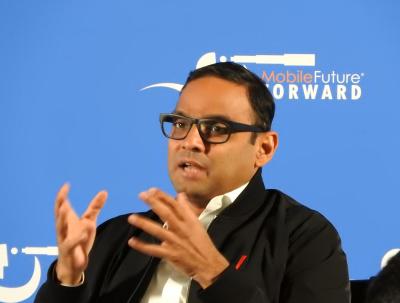SEATTLE—Although Verizon’s network is getting slammed left and right by T-Mobile and its 5G claims, its bet on fixed wireless access (FWA) thus far appears to be paying off, and that includes the enterprise side of the business.
In fact, the relatively new Verizon Business CEO, Sampath Sowmyanarayan, said it’s growing at an unprecedented clip. Sowmyanarayan assumed his current role this past summer, replacing Tami Erwin. He’s been with Verizon since 2014 and before that, worked in the consulting industry at KPMG and the Boston Consulting Group (BCG).

“I’ve been doing this for a pretty long time, and I have never seen a product fly off the shelf this fast,” he told Fierce on the sidelines of the Mobile Future Forward event last week. “We’ve seen almost year-on-year 30X jump in sales.”
Verizon started offering its 5G Home service, based on FWA, around 2018 in select markets. It also offers 5G Business Internet and LTE Business Internet plans at various speed and price tiers.
As of the end of the second quarter 2022, Verizon’s FWA business customers totaled 316,000 and its consumer FWA customers totaled 384,000, so it’s pretty close to a 50/50 split between the two.
One reason for this shift is simple: Cable broadband is not that good, he said. “It’s inconsistent and when something goes down, it takes too long to bring up,” he said, noting the broadband losses at cable operators in recent quarters.
For the last 10 years, cable broadband “has had an incredible run because we didn’t have a nationwide broadband product,” he said. “We do now,” leading to a major shift in the market for nationwide broadband “away from the cable operators to players like us.”
Unsurprisingly, he said Verizon offers a better product in terms of reliability and speed.
Using a 4,000-store deployment as an example, he said it would take cable two to three years to get it covered. “We got it done in three to four months. All we did was we shipped a router with a SIM in it,” and they were able to install it right away.
Verizon’s FWA business customers are using a mix of C-band, millimeter wave and LTE. If somebody buys the product in an area that has been upgraded to C-band, the service automatically uses the newer spectrum, he explained. If the product is activated where there is no C-band or mmWave, it will move to the speedier band when that’s deployed.
“Momentum is on our side,” he said, reiterating that 80% of all the FWA they sell is for primary connections. About half of Verizon’s FWA subs come from cable and the other half can’t be served by cable because they’re more of a mobility play, like food trucks, squad cars or an off-site Covid center.
This certainly isn’t the first run for FWA; it’s made appearances over the years in various iterations. The difference is nowadays, the CPE is much better and the network can handle it. 5G offers the kind of throughput and coverage that didn’t exist before, and that’s a big change, he said.
T-Mobile limits eligibility for its regular FWA service because it doesn’t have enough capacity to deliver a great home broadband experience to everyone. That’s why it introduced a Home Internet Lite version with less data but with wider availability.
“We don’t have that issue,” Sowmyanaraya said. “Part of it is spectrum… We’re very agile in our deployment,” with low, C-band (mid) and millimeter wave (high) band spectrum at its disposal. “We’ve never had to say no to anybody on the business side.”
During its investor day event earlier this year, Verizon said it expects to have 1 million FWA business customers by the end of 2025. Sowmyanaraya said he thinks they're going to go well over that amount. A lot of the business end users are retail establishments, branch offices, public sector agencies and construction sites.
Getting edgy
Verizon likes to point out that it’s the only carrier to strike partnerships with all three cloud providers – Google, Amazon and Microsoft. “We want to make it very easy to deploy edge applications,” he said. “We’ve already done the hard work of integrating with the cloud providers.”
If a customer wants to develop applications at the edge, “you can come through any of these front doors,” he said, referring to Google, Amazon and Microsoft. “We want to take away the hard work. We want developers and ecosystem people to build on top of it. Our value-add is in the connectivity integration with the cloud providers.”
It’s a new direction. Historically, “telcos have not been the easiest to do business with,” he said. “But that is the fundamental change. We are partner first when it comes to the mobile edge compute.”

